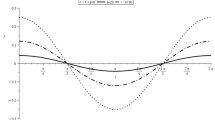In this section we construct a sequence of changes of the space variables and time
leading to the proof of Proposition 2.1.
Rescaling (2.1) implies
\(\varepsilon\dot{x}=\mu^{2}X^{\prime}_{1},\ \dot{y}=\mu Y^{\prime}_{1},\ \dot{z}=\mu Z^{\prime}_{1},\)
where the prime stands for the derivative with respect to the “semi-fast” time \(s\).
We substitute (2.1) into (1.6) and use the Taylor formula for the
right-hand side of (1.6) in a neighborhood of the point \((x,y,z;\delta)=(0,0,0;0)\).
Then, taking (1.7) and (1.8) into account, we obtain
$$\displaystyle\begin{aligned} \displaystyle X^{\prime}_{1}&\displaystyle=F^{\prime}_{y}Y_{1}+F^{\prime}_{z}Z_{1}+\frac{1}{2}F^{\prime\prime}_{x^{2}}X_{1}^{2}+\mu\left[\sigma F^{\prime\prime}_{x\delta}X_{1}+F^{\prime\prime}_{xy}X_{1}Y_{1}+F^{\prime\prime}_{xz}X_{1}Z_{1}+\frac{1}{6}F^{\prime\prime\prime}_{x^{3}}X_{1}^{3}\right]\\ &\displaystyle\quad+\mu^{2}\left[\sigma F^{\prime\prime}_{y\delta}Y_{1}+\sigma F^{\prime\prime}_{z\delta}Z_{1}+\frac{1}{2}F^{\prime\prime}_{y^{2}}Y_{1}^{2}+\frac{1}{2}F^{\prime\prime}_{z^{2}}Z_{1}^{2}+F^{\prime\prime}_{yz}Y_{1}Z_{1}\right.\\ &\displaystyle\quad+\left.X_{1}^{2}\left(\frac{1}{2}\sigma F^{\prime\prime\prime}_{x^{2}\delta}+\frac{1}{2}F^{\prime\prime\prime}_{x^{2}y}Y_{1}+\frac{1}{2}F^{\prime\prime\prime}_{x^{2}z}Z_{1}\right)+\frac{1}{24}F^{(4)}_{x^{4}}X_{1}^{4}\right]+O(\mu^{3}),\\ \displaystyle Y^{\prime}_{1}&\displaystyle=G^{\prime}_{1x}X_{1}+\mu\left[G^{\prime}_{1y}Y_{1}+G^{\prime}_{1z}Z_{1}+\frac{1}{2}G^{\prime\prime}_{1x^{2}}X_{1}^{2}\right]\\ &\displaystyle\quad+\mu^{2}\left[X_{1}\left(\sigma G^{\prime\prime}_{1x\delta}+G^{\prime\prime}_{1xy}Y_{1}+G^{\prime\prime}_{1xz}Z_{1}\right)+\frac{1}{6}G^{\prime\prime\prime}_{1x^{3}}X_{1}^{3}\right]+O(\mu^{3}),\\ \displaystyle Z^{\prime}_{1}&\displaystyle=G^{\prime}_{2x}X_{1}+\mu\left[G^{\prime}_{2y}Y_{1}+G^{\prime}_{2z}Z_{1}+\frac{1}{2}G^{\prime\prime}_{2x^{2}}X_{1}^{2}\right]\\ &\displaystyle\quad+\mu^{2}\left[X_{1}\left(\sigma G^{\prime\prime}_{2x\delta}+G^{\prime\prime}_{2xy}Y_{1}+G^{\prime\prime}_{2xz}Z_{1}\right)+\frac{1}{6}G^{\prime\prime\prime}_{2x^{3}}X_{1}^{3}\right]+O(\mu^{3}).\end{aligned}$$
(A.1)
Here and below in this section all derivatives of the functions
\(F\),
\(G_{1}\) and
\(G_{2}\) are evaluated at the point
\((x,y,z;\delta)=(0,0,0;0)\).
For \(\mu=0\) the system takes the form
$$\displaystyle\begin{aligned} \displaystyle X^{\prime}_{1}&\displaystyle=F^{\prime}_{y}Y_{1}+F^{\prime}_{z}Z_{1}+\frac{1}{2}F^{\prime\prime}_{x^{2}}X_{1}^{2},\\ \displaystyle Y^{\prime}_{1}&\displaystyle=G^{\prime}_{1x}X_{1},\\ \displaystyle Z^{\prime}_{1}&\displaystyle=G^{\prime}_{2x}X_{1}.\end{aligned}$$
Denoting
$$D=F^{\prime}_{y}G_{1x}^{\prime}+F^{\prime}_{z}G_{2x}^{\prime},$$
(A.2)
condition
(1.9) takes the form
Note that for \(\mu=0\) the system (A.1) has an obvious integral:
$$-G_{2x}^{\prime}Y_{1}+G_{1x}^{\prime}Z_{1}.$$
Then, taking this into account, we introduce new variables
\((X_{2},Y_{2},Z_{2})\) by
$$X_{2}=X_{1},\qquad Y_{2}=F^{\prime}_{y}Y_{1}+F^{\prime}_{z}Z_{1},\qquad Z_{2}=-G_{2x}^{\prime}Y_{1}+G_{1x}^{\prime}Z_{1}.$$
Due to
(A.3) the inverse change of variables is well-defined:
$$X_{1}=X_{2},\qquad Y_{1}=\frac{1}{D}(G_{1x}^{\prime}Y_{2}-F^{\prime}_{z}Z_{2}),\qquad Z_{1}=\frac{1}{D}(G_{2x}^{\prime}Y_{2}+F^{\prime}_{y}Z_{2})\vspace{-1mm}$$
and the system
(A.1) can be rewritten as
$$\displaystyle\begin{aligned} \displaystyle X^{\prime}_{2}&\displaystyle=Y_{2}+\frac{1}{2}F^{\prime\prime}_{x^{2}}X_{2}^{2}+\mu\left\{X_{2}\left[\gamma_{0}^{(2)}+\gamma_{1}^{(2)}Y_{2}+\gamma_{2}^{(2)}Z_{2}\right]+\gamma_{3}^{(2)}X_{2}^{3}\right\}\\ &\displaystyle\quad+\mu^{2}\biggl{\{}\gamma_{4}^{(2)}Y_{2}+\gamma_{5}^{(2)}Z_{2}+\gamma_{6}^{(2)}Y_{2}^{2}+\gamma_{7}^{(2)}Z_{2}^{2}+\gamma_{8}^{(2)}Y_{2}Z_{2}\\ &\displaystyle\quad+X_{2}^{2}\left[\gamma_{9}^{(2)}+\gamma_{10}^{(2)}Y_{2}+\gamma_{11}^{(2)}Z_{2}\right]+\gamma_{12}^{(2)}X_{2}^{4}\biggr{\}}+O(\mu^{3}),\\ \displaystyle Y^{\prime}_{2}&\displaystyle=DX_{2}+\mu\left(\alpha_{1}^{(2)}Y_{2}+\alpha_{2}^{(2)}Z_{2}+\alpha_{3}^{(2)}X_{2}^{2}\right)\\ &\displaystyle\quad+\mu^{2}\left\{X_{2}\left[\alpha_{4}^{(2)}+\alpha_{5}^{(2)}Y_{2}+\alpha_{6}^{(2)}Z_{2}\right]+\alpha_{7}^{(2)}X_{2}^{3}\right\}+O(\mu^{3}),\\ \displaystyle Z^{\prime}_{2}&\displaystyle=\mu\left[\beta_{1}^{(2)}Y_{2}+\beta_{2}^{(2)}Z_{2}+\beta_{3}^{(2)}X_{2}^{2}\right]+\mu^{2}\left\{X_{2}\left[\beta_{4}^{(2)}+\beta_{5}^{(2)}Y_{2}+\beta_{6}^{(2)}Z_{2}\right]+\beta_{7}^{(2)}X_{2}^{3}\right\}+O(\mu^{3}),\end{aligned}$$
(A.4)
where
$$\displaystyle\gamma_{0}^{(2)}=\sigma F^{\prime\prime}_{x\delta},\quad\gamma_{1}^{(2)}=\frac{1}{D}\left(F^{\prime\prime}_{xy}G^{\prime}_{1x}+F^{\prime\prime}_{xz}G^{\prime}_{2x}\right),\quad\gamma_{2}^{(2)}=\frac{1}{D}\left(F^{\prime\prime}_{xz}F^{\prime}_{y}-F^{\prime\prime}_{xy}F^{\prime}_{z}\right),\quad\gamma_{3}^{(2)}=\frac{1}{6}F^{\prime\prime\prime}_{x^{3}},$$
$$\displaystyle\begin{aligned}
\displaystyle\alpha_{1}^{(2)}&\displaystyle=\frac{1}{D}(F^{\prime}_{y}G^{\prime}_{1x}G^{\prime}_{1y}+F^{\prime}_{y}G^{\prime}_{1z}G^{\prime}_{2x}+F^{\prime}_{z}G^{\prime}_{1x}G^{\prime}_{2y}+F^{\prime}_{z}G^{\prime}_{2x}G^{\prime}_{2z}),\\
\displaystyle\alpha_{2}^{(2)}&\displaystyle=\frac{1}{D}(F^{\prime 2}_{y}G^{\prime}_{1z}-F^{\prime 2}_{z}G^{\prime}_{2y}+F^{\prime}_{y}F^{\prime}_{z}G^{\prime}_{2z}-F^{\prime}_{y}F^{\prime}_{z}G^{\prime}_{1y}),\quad\alpha_{3}^{(2)}=\frac{1}{2}(F^{\prime}_{y}G^{\prime\prime}_{1x^{2}}+F^{\prime}_{z}G^{\prime\prime}_{2x^{2}}),\\
\displaystyle\beta_{1}^{(2)}&\displaystyle=\frac{1}{D}(G^{\prime 2}_{1x}G^{\prime}_{2y}-G^{\prime}_{1x}G^{\prime}_{2x}G^{\prime}_{1y}+G^{\prime}_{1x}G^{\prime}_{2x}G^{\prime}_{2z}-G^{\prime 2}_{2x}G^{\prime}_{1z}),\\
\displaystyle\beta_{2}^{(2)}&\displaystyle=\frac{1}{D}(-F^{\prime}_{z}G^{\prime}_{1x}G^{\prime}_{2y}+F^{\prime}_{z}G^{\prime}_{2x}G^{\prime}_{1y}+F^{\prime}_{y}G^{\prime}_{1x}G^{\prime}_{2z}-F^{\prime}_{y}G^{\prime}_{2x}G^{\prime}_{1z}),\\
\displaystyle\beta_{3}^{(2)}&\displaystyle=\frac{1}{2}(G^{\prime}_{1x}G^{\prime\prime}_{2x^{2}}-G^{\prime}_{2x}G^{\prime\prime}_{1x^{2}}).
\end{aligned}$$
(A.5)
We do not write any formulae for the coefficients of terms of order
\(\mu^{2}\) (i. e.,
\(\gamma^{(2)}_{i}\),
\(\alpha^{(2)}_{i}\),
\(\beta^{(2)}_{i}\) with
\(i\geqslant 4\)) since they do not appear in the main result of this paper.
In the system (A.4) the variable \(Z_{2}\) is slow and the leading term of
the right-hand side in the first equation does not contain \(Z_{2}\).
The next change of variables is aimed at simplifying the leading term of the right-hand side
in (A.4). Using the scaling
$$X_{2}=kX_{3},\quad Y_{2}=mY_{3},\quad Z_{2}=Z_{3},\quad s=n\tau,$$
we represent
(A.4) as
$$\displaystyle\begin{aligned}
\displaystyle X^{\prime}_{3}&\displaystyle=\frac{nm}{k}Y_{3}+\frac{1}{2}F^{\prime\prime}_{x^{2}}knX_{3}^{2}+O(\mu),\\
\displaystyle Y^{\prime}_{3}&\displaystyle=D\frac{kn}{m}X_{3}+O(\mu),\\
\displaystyle Z^{\prime}_{3}&\displaystyle=O(\mu).
\end{aligned}$$
We fix the factors
\(m\),
\(k\) and
\(n\) such that
$$m=\frac{D}{F^{\prime\prime}_{x^{2}}},\quad k=\frac{\sqrt{-2D}}{F^{\prime\prime}_{x^{2}}},\quad n=\sqrt{\frac{2}{-D}}.$$
Then the leading term of
(A.4) is simplified to
$$\displaystyle X^{\prime}_{3}=X_{3}^{2}-Y_{3},$$
$$\displaystyle Y^{\prime}_{3}=2X_{3},$$
$$\displaystyle Z^{\prime}_{3}=0.$$
Here the prime stands for the derivative with respect to
\(\tau\).
And the whole system
(A.4) takes the form
$$\displaystyle\begin{aligned}
\displaystyle X^{\prime}_{3}&\displaystyle=X_{3}^{2}-Y_{3}+\mu\left(X_{3}(\gamma_{0}^{(3)}+\gamma_{1}^{(3)}Y_{3}+\gamma_{2}^{(3)}Z_{3})+\gamma_{3}^{(3)}X_{3}^{3}\right)\\
&\displaystyle\quad+\mu^{2}\biggl{\{}\gamma_{4}^{(3)}Y_{3}+\gamma_{5}^{(3)}Z_{3}+\gamma_{6}^{(3)}Y_{3}^{2}+\gamma_{7}^{(3)}Z_{3}^{2}+\gamma_{8}^{(3)}Y_{3}Z_{3}\\
&\displaystyle\quad+X_{3}^{2}\left[\gamma_{9}^{(3)}+\gamma_{10}^{(3)}Y_{3}+\gamma_{11}^{(3)}Z_{3}\right]+\gamma_{12}^{(3)}X_{3}^{4}\biggr{\}}+O(\mu^{3}),\\
\displaystyle Y^{\prime}_{3}&\displaystyle=2X_{3}+\mu(\alpha_{1}^{(3)}Y_{3}+\alpha_{2}^{(3)}Z_{3}+\alpha_{3}^{(3)}X_{3}^{2})\\
&\displaystyle\quad+\mu^{2}(X_{3}(\alpha_{4}^{(3)}+\alpha_{5}^{(3)}Y_{3}+\alpha_{6}^{(3)}Z_{3})+\alpha_{7}^{(3)}X_{3}^{3})+O(\mu^{3}),\\
\displaystyle Z^{\prime}_{3}&\displaystyle=\mu\left(\beta_{1}^{(3)}Y_{3}+\beta_{2}^{(3)}Z_{3}+\beta_{3}^{(3)}X_{3}^{2}\right)\\
&\displaystyle\quad+\mu^{2}(X_{3}(\beta_{4}^{(3)}+\beta_{5}^{(3)}Y_{3}+\beta_{6}^{(3)}Z_{3})+\beta_{7}^{(3)}X_{3}^{3})+O(\mu^{3}),
\end{aligned}$$
(A.6)
where
$$\begin{gathered}\displaystyle\gamma_{0}^{(3)}=\sqrt{\frac{2}{-D}}\gamma_{0}^{(2)},\quad\gamma_{1}^{(3)}=-\frac{\sqrt{-2D}}{F^{\prime\prime}_{x^{2}}}\gamma_{1}^{(2)},\quad\gamma_{2}^{(3)}=\sqrt{\frac{2}{-D}}\gamma_{2}^{(2)},\quad\gamma_{3}^{(3)}=\frac{2\sqrt{-2D}}{F^{\prime\prime 2}_{x^{2}}}\gamma_{3}^{(2)},\\ \displaystyle\alpha_{1}^{(3)}=\sqrt{\frac{2}{-D}}\alpha_{1}^{(2)},\quad\alpha_{2}^{(3)}=\sqrt{\frac{2}{-D}}\frac{F^{\prime\prime}_{x^{2}}}{D}\alpha_{2}^{(2)},\quad\alpha_{3}^{(3)}=-\frac{2\sqrt{2}}{F^{\prime\prime}_{x^{2}}\sqrt{-D}}\alpha_{3}^{(2)},\\ \displaystyle\beta_{1}^{(3)}=-\frac{\sqrt{-2D}}{F^{\prime\prime}_{x^{2}}}\beta_{1}^{(2)},\quad\beta_{2}^{(3)}=\sqrt{\frac{2}{-D}}\beta_{2}^{(2)},\quad\beta_{3}^{(3)}=\frac{2\sqrt{-2D}}{F^{\prime\prime 2}_{x^{2}}}\beta_{3}^{(2)}.\end{gathered}$$
(A.7)
The final change of variables is aimed at excluding as many coefficients
\(\alpha_{i},\beta_{i},\gamma_{i}\) as possible. One may remark that Eqs.
(A.6) truncated (after removing
terms of order
\(O(\mu^{3})\)), and in fact already
(A.1),
possess a symmetry. Namely, they are invariant under the transformation
$$(X_{3},\tau,\mu)\mapsto(-X_{3},-\tau,-\mu).$$
(A.8)
The origin of this symmetry is the scaling
(2.1). Moreover, if one substitutes
(2.1) into
(1.6) and expands the right-hand side of
(1.6) in a neighborhood of the point
\((x,y,z;\delta)=(0,0,0;0)\) up to terms of order
\(O(\mu^{N})\) (for arbitrary
\(N\in\mathbb{N}\)), then the truncated system (obtained by omitting the terms
\(O(\mu^{N})\)) will also be invariant under
(A.8). It was mentioned above that this inner symmetry simplifies the study of the Poincaré map. Thus, our purpose is not only to exclude a number of coefficients and keep the leading term, but also to preserve this symmetry.
For this reason we consider the following near-identity change of variables:
$$\left(\begin{array}[]{c}X_{3}\\ Y_{3}\\ Z_{3}\end{array}\right)=(I+\mu A+\mu^{2}B)\left(\begin{array}[]{c}\xi\\ \eta\\ \zeta\end{array}\right),$$
(A.9)
where
$$A=\left(\begin{array}[]{ccc}0&B_{1}&C_{1}\\ A_{2}&0&0\\ A_{3}&0&0\end{array}\right),\qquad B=\left(\begin{array}[]{ccc}a_{1}&0&0\\ 0&b_{2}&c_{2}\\ 0&b_{3}&c_{3}\end{array}\right).$$
Inverting
(A.9) yields
$$\left(\begin{array}[]{c}\xi\\ \eta\\ \zeta\end{array}\right)=(I-\mu A+\mu^{2}(A^{2}-B))\left(\begin{array}[]{c}X_{3}\\ Y_{3}\\ Z_{3}\end{array}\right)+O(\mu^{3}).$$
(A.10)
In order to simplify the first-order terms, we choose
$$B_{1}=-\frac{1}{2}\gamma_{1}^{(3)},\ C_{1}=-\frac{1}{2}\gamma_{2}^{(3)},\ A_{2}=\alpha_{3}^{(3)},\ A_{3}=\beta_{3}^{(3)}.$$
Then by an appropriate choice of
\(a_{1}\),
\(b_{2}\),
\(b_{3}\) and
\(c_{2}\) we remove four coefficients of
order
\(\mu^{2}\) and
obtain the following system:
$$\displaystyle\begin{aligned}
\displaystyle\xi^{\prime}&\displaystyle=\xi^{2}-\eta+\mu f_{1}+\mu^{2}g_{1}+O(\mu^{3}),\\
\displaystyle\eta^{\prime}&\displaystyle=2\xi+\mu f_{2}+\mu^{2}g_{2}+O(\mu^{3}),\\
\displaystyle\zeta^{\prime}&\displaystyle=\mu f_{3}+\mu^{2}g_{3}+O(\mu^{3}),
\end{aligned}$$
where
$$\displaystyle\begin{aligned}
\displaystyle f_{1}&\displaystyle=\gamma_{0}\xi+\gamma\xi^{3},\\
\displaystyle g_{1}&\displaystyle=\gamma_{1}\eta+\gamma_{2}\eta^{2}+\gamma_{3}\zeta^{2}+\gamma_{4}\eta\zeta+\xi^{2}(\gamma_{5}\eta+\gamma_{6}\zeta)+\gamma_{7}\xi^{4},\\
\displaystyle f_{2}&\displaystyle=\alpha_{1}\eta+\alpha_{2}\zeta,\\
\displaystyle g_{2}&\displaystyle=\xi(\alpha_{3}\eta+\alpha_{4}\zeta)+\alpha_{5}\xi^{3},\\
\displaystyle f_{3}&\displaystyle=\beta_{1}\eta+\beta_{2}\zeta,\\
\displaystyle g_{3}&\displaystyle=\xi(\beta_{3}\eta+\beta_{4}\zeta)+\beta_{5}\xi^{3}
\end{aligned}$$
and
$$\begin{gathered}\displaystyle\gamma_{0}=\gamma_{0}^{(3)}+\gamma_{1}^{(3)}-\alpha_{3}^{(3)},\qquad\gamma=\gamma_{3}^{(3)},\\ \displaystyle\alpha_{1}=\alpha_{1}^{(3)}+\alpha_{3}^{(3)}-\gamma_{1}^{(3)},\quad\alpha_{2}=\alpha_{2}^{(3)}-\gamma_{2}^{(3)},\quad\beta_{1}=\beta_{1}^{(3)}+\beta_{3}^{(3)},\quad\beta_{2}=\beta_{2}^{(3)}.\end{gathered}$$
(A.11)
This finishes the proof of Proposition 1.





